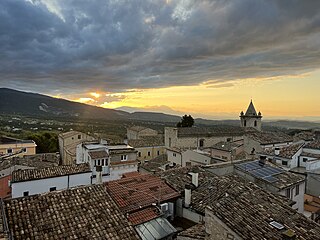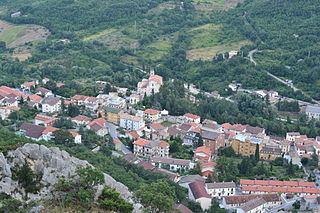
General Gabriele D'Annunzio, Prince of Montenevoso, sometimes written d'Annunzio as he used to sign himself, was an Italian poet, playwright, orator, journalist, aristocrat, and Royal Italian Army officer during World War I. He occupied a prominent place in Italian literature from 1889 to 1910 and later political life from 1914 to 1924. He was often referred to under the epithets il Vate and il Profeta.

Abruzzo, historically known as Abruzzi, is a region of Southern Italy with an area of 10,763 square km and a population of 1.3 million. It is divided into four provinces: L'Aquila, Teramo, Pescara, and Chieti. Its western border lies 80 km (50 mi) east of Rome. Abruzzo borders the region of Marche to the north, Lazio to the west and north-west, Molise to the south and the Adriatic Sea to the east. Geographically, Abruzzo is divided into a mountainous area in the west, which includes the highest massifs of the Apennines, such as the Gran Sasso d'Italia and the Maiella, and a coastal area in the east with beaches on the Adriatic Sea.

Pescara is the capital city of the Province of Pescara, in the Abruzzo region of Italy. It is the most populated city in Abruzzo, with 118,657 residents. Located on the Adriatic coast at the mouth of the Aterno-Pescara River, the present-day municipality was formed in 1927 joining the municipalities of the old Pescara fortress, the part of the city to the south of the river, and Castellamare Adriatico, the part of the city to the north of the river. The surrounding area was formed into the province of Pescara.

The province of Chieti is a province in the Abruzzo region of Italy. Its provincial capital is the city Chieti, which has a population of 50,770 inhabitants. The province has a total population of 387,649 inhabitants as of 2017 and spans an area of 2,599.58 square kilometres (1,003.70 sq mi). It is divided into 104 comuni (comune) and the provincial president is Mario Pupillo.

Ortona is a coastal town and municipality of the Province of Chieti in the Italian region of Abruzzo, with some 23,000 inhabitants.

Chieti is a city and comune (municipality) in Southern Italy, 200 kilometres east of Rome. It is the capital of the province of Chieti, in the Abruzzo region.

Guardiagrele is a town and comune in the province of Chieti, part of the Abruzzo region of central Italy. It is in the foothills of the Maiella mountain at an elevation of around 576 metres (1,890 ft). Its population numbers about 10,000.
The Music of Abruzzo is a style of music in Abruzzo, Italy. Abruzzo is sparsely populated and is very mountainous, but the area has a musical history involving opera, sacred music, and even the town band. The great composer of delicate, 19th-century airs, Francesco Paolo Tosti, dedicated a series of compositions to the area, the romanze abruzzesi.

D'Annunzio University is a public research university located in Chieti and Pescara, neighbouring cities in the region of Abruzzo, Italy. Established in 1960 as a higher education institute and named after writer and poet Gabriele D'Annunzio, it was officially recognised as an independent university in 1965 by Minister Luigi Gui.

Casoli a comune and town in the Province of Chieti in the Abruzzo region of Italy. It is situated on a foothill of the Majella mountain, at the base of which runs the Aventino River, tributary of the Sangro. As of 31 December 2004, it had a population of 5,901 and an area of 66 square kilometres (25 sq mi).

Castel Frentano is a comune and town in the province of Chieti in the Abruzzo region of Italy.

Lama dei Peligni is a comune and town in the Province of Chieti in the Abruzzo region of Italy with 1,155 inhabitants. It is also part of the Aventino-Medio Sangro mountain community and the municipal territory is included in the Majella National Park. The town, known to naturalists as the country of chamois, is located in a florofaunal area of particular interest.

Taranta Peligna is a comune and town in the province of Chieti in the Abruzzo region of central Italy. It is 57 kilometres (35 mi) from Chieti.
The Leonardo da Vinci University, often simply abbreviated as "Unidav" is a private university founded in 2004 in Torrevecchia Teatina, Italy. It was created and promoted by the D'Annunzio University of Chieti–Pescara.

Luciano D'Alfonso is an Italian politician. He was the mayor of Pescara from 2003 to 2009. He has served as the president of Abruzzo since 2014.
Ettore Paratore was an Italian Latinist and academic.

Basilio Cascella was an Italian artist, active from the late nineteenth century to the mid-twentieth century.
Sara Santoro Bianchi (1950–2016) was an Italian archaeologist, classical scholar and educator. She is remembered for her collaboration in projects focusing on the Insula del Centenario in Pompeii, Castelraimondo del Fiuli, Bliesbruck on the French-German border, and the excavation of the Amphitheatre of Durrës in Albania. She has served as director of the Archaeological Museum of Bazzano, Province of Bologna, and as a professor of archaeology and Greek and Roman art at the University of Parma and at the D'Annunzio University of Chieti–Pescara.















